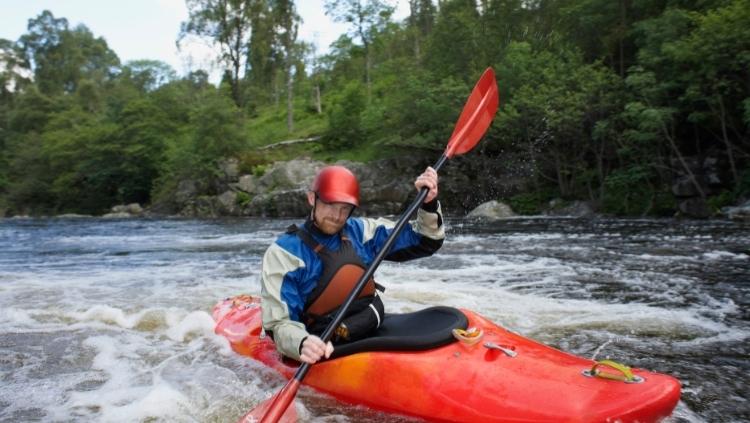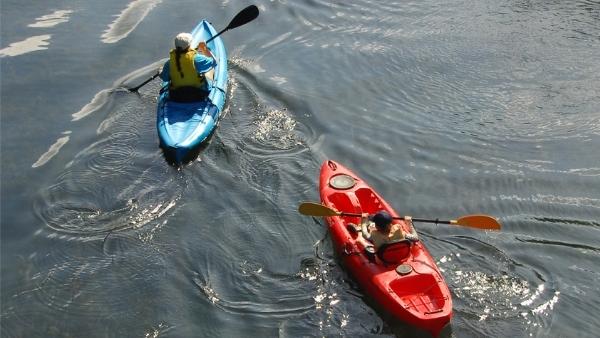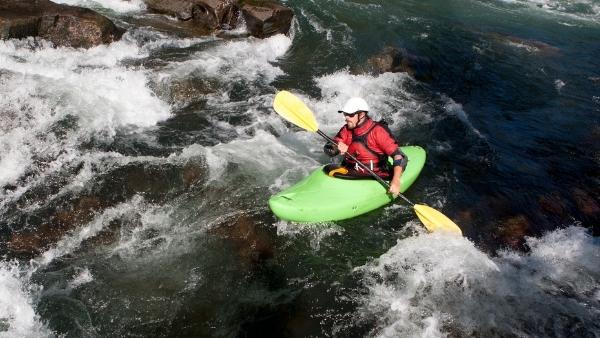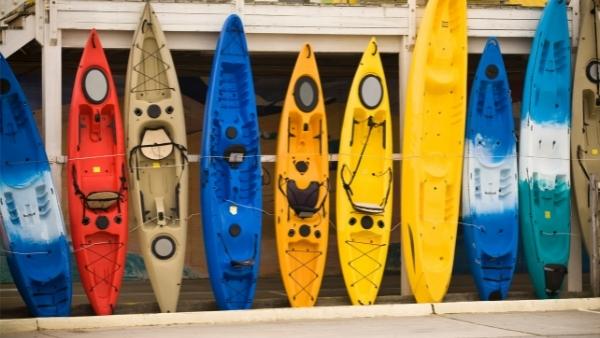Buying a kayak is an exciting experience for an outdoorsman. However, if you are new to kayaking, you’re probably looking for a kayak type comparison. You might be surprised to learn that there are many different types of kayaks designed for specific styles of kayaking.
Before you jump into buying one, learn about the variations in construction, design, propulsion method, and use. You can make an informed decision after comparing kayak types so you can find one that best suits your needs.
Different Types of Kayaks by Use
Kayaks are most often categorized by intended use. Whether you want a simple recreational kayak for fun weekend trips with the family or a touring kayak to track your performance, you can narrow down your preferences by understanding the features and characteristics of each type.
Fishing Kayaks
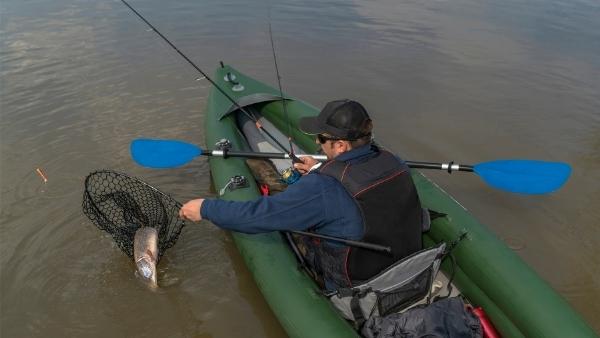
- Available in sit-on-top or sit-in
- Have a spacious deck that measures between 30 and 40 inches wide
- Equipped with rod holders, mounting spots for a motor or pedal drive system, an anchor system, gear tracks, and a fish finder
- Made of fiberglass or Aramid
These kayaks are built for stability. Some even allow you to fish while standing up.
Recommended: Best Fishing Kayaks: The Definitive Guide (In-Depth Reviews)
Pros and Cons
These are easily stored and not difficult to get in and out of the water. They come in varying deck sizes to meet your needs, and some offer storage. They can also be difficult to paddle, and they move slowly, making them incompatible with long journeys.
Recreational Kayaks
Recreational kayaks are about creating a fun experience. They do not come with all the fancy bells and whistles of the specialized kayaks, and that makes them an excellent option for a first-timer. Some characteristics of recreationals include:
- Available as a sit-in or sit-on-top
- A shorter hull, between 9 and 12 feet
- A wider beam, measuring between 28 and 34 inches
- Made for flat waters, such as lakes, ponds, and slow rivers
- Built with polyethylene material
These are user-friendly and designed to make you feel comfortable on an easy ride.
Pros and Cons
These kayaks offer increased maneuverability, which provides a more stable ride. However, the increase in maneuverability also makes them more challenging to keep in a straight line, making them more tiring to paddle and unsuitable for long rides. You also want to stay away from waves and rapids.
Touring Kayaks
Touring kayaks are a specialized and very different type of kayak from recreationals. The defining characteristics of touring kayaks include:
- Available as a sit-in only
- Sleek in appearance
- A long hull, between 12 and 20 feet
- A narrow beam, between 18 and 28 inches in width
- Plenty of cargo space
- Made of Aramid fiber
Some are fitted with a rudder system that improves the kayaking experience in open waters. They are built for speed and efficiency and are great for tracking performance. The type of user best suited for a touring kayak is looking for something designed for long distances on day trips or excursions lasting several days.
Pros and Cons
This type of kayak is designed for efficient tracking. You can travel in a straight line for long periods with minimal effort. The storage capabilities make it great for journeys that require supplies and equipment.
Unfortunately, the same design that makes it fast also makes it difficult to make tight turns. Evacuating and re-entering the kayak has to be taught by an instructor, and they can be hard to transport.
Sea Kayaks
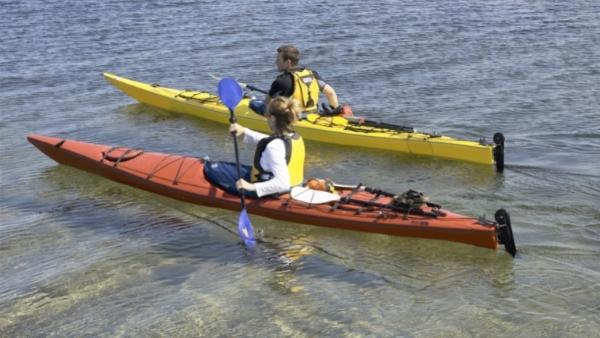
- A sharp V-shaped hull
- A more pronounced rocker, which is shape the front to the back
- Built-in thigh braces
- Better suitability for rougher waters
- Made from fiberglass or Kevlar
Like the touring kayak, they are sit-in only. These are best suited for experienced kayakers that need a kayak for open water.
Pros and Cons
Sea kayaks are designed for efficient tracking along coastal waters. They are easier to control and offer ample storage space for extra-long expeditions.
The biggest con is that they only operate best in one type of environment: rough, open waters. On flat water, they are hard to maneuver and less stable.
Whitewater Kayaks
Whitewater kayaks are for the adventurer. They are designed to handle whitewater rapids and perform amazing tricks. Features include:
- Available as a sit-in only
- Usually made of hard plastics
- A short hull, between 4 and 10 feet
- A wide beam
- A pronounced rocker
- Function best in rocky environments with fast-flowing water
- Come in two types: playboats and creek boats
- Made of polyethylene plastic
Whitewater kayaks prioritize maneuverability and responsiveness above all else.
Pros and Cons
Playboats are strong and agile, making them excellent for rocky environments. Creekboats are longer and denser than playboats, making them better for narrow waterways.
Each has cons as well. The playboat’s design makes it more unstable and slow outside its intended environment. Creekboats have limited storage and are not feasible for long rides.
Crossover Kayaks
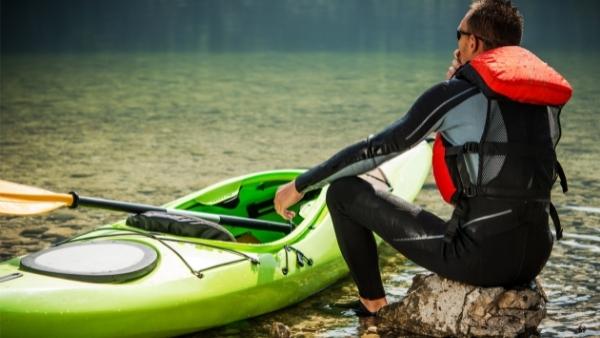
- A recreational style hull
- A planing hull to make it whitewater-ready
- Pole holders for fishing
- Available as a sit-in or sit-on-top
- Made from rotomolded polyethylene
The type of crossover kayak you have will come with features characteristic of the types it mimics.
Pros and Cons
The crossover kayak is perfect for excursions that carry you across various environments. They are an excellent option for new kayakers that want to try more than one style of kayaking.
However, crossover kayaks are generally not capable of the high-end performance that characterizes a specialized type of kayak.
Kayak Type Comparison: What is Different Among Them
Comparing kayaks is an effective way to decide what type is best for you. Many of them have features and functions that crossover. Some features are also available across many types of kayaks. Take a look at some prevalent comparisons that help you better understand the similarities between these types.
Fishing Kayak vs. Regular Kayak
Regular kayaks and recreational kayaks are interchangeable. Fishing kayaks are designed to accommodate anglers, but they can function much like recreational kayaks. Some significant differences between this kayak type comparison include:
Size. Fishing kayaks are shorter and wider than recreational.
Structure. Fishing kayaks are almost always sit-on-top, whereas recreational are more commonly sit-inside.
Stability. A kayak’s stability is measured by how easily it can capsize. More width typically translates into greater stability. Fishing kayaks have a wider design, which makes them more stable.
Tracking. Recreational kayaks provide better tracking, primarily because fishing kayaks are not designed to move continuously.
Overall, choosing between these two types is based on your intended use and skill level. If you prefer functionality over design, the fishing kayak might be a better choice. If you are a beginner that wants to start slow, the recreational kayak is absolutely your ideal option.
Sit-On-Top vs. Sit-Inside
All kayaks are either sit-on-top or sit-inside, respectively known as SOT or SIS. All types of kayaks come in either one or both styles.
As the name implies, the SOT style allows the kayaker to ride on top with their legs exposed. The SIS style requires the rider to sit inside the kayak’s hull. The body is covered from the waist down.
SISs are the most commonly used, but SOTs are gaining popularity. Both styles are very safe and have virtually no effect on stability. The best way to determine what style you like is to try them out for yourself.
Tandem vs. Solo
Tandem and solo kayaks differ primarily in the number of people that can use them. A solo kayak is designed for a singular paddling experience whereas tandems, or two-seaters, are designed for two people.
If you are planning your future kayaking experiences with a partner, a tandem is generally less expensive than buying two separate kayaks. However, you have to be willing to work together to paddle. And they can be a bit more difficult to transport.
Hardshell vs. Inflatable vs. Folding
Hardshell, inflatable, and folding kayaks are defined as follows:
Hardshell kayaks are the most common. They have a rigid hull and come in various materials, including plastic, wood, fiberglass, carbon fiber, and Aramid fiber. The synthetic materials are more lightweight.
Inflatable kayaks are becoming more popular. They are lightweight, more stable, more buoyant, portable, less expensive, and can carry more weight.
Folding kayaks are collapsible. They share features with both hardshell and inflatable designs. What makes them unique is that they are rigid but foldable. They are more expensive than most inflatables, and less durable than hard shells.
Overall, all three have features that are suitable for a beginner. If you travel and hike often, folding kayaks are a great option. If you are looking for something more budget-friendly, opt for the inflatable.
Doing a kayak type comparison, such as fishing kayak vs. regular kayak, may seem like simple questioning. But it warrants complex answers.
As you wade through the different types of kayaks, remember to consider construction, design, intended use, and the number of paddlers. Check out safety tips and enjoy your venture into the world of a ‘yakker.

